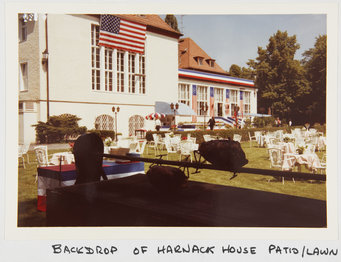Officers’ mess for the US Army
1945: The arrival of the Americans

The Americans found it intact and well suited to use as a hotel and established an officers’ mess in the House. The south-west section of Berlin, as the city was divided by the Allies, was under US control. In fact, American forces’ headquarters were not far from Harnack House. From that point on, Harnack House represented a piece of American in Berlin and contributed to German-American relations. Instead of scientists, it was therefore members of the Berlin Brigade who became lunchtime regulars at Harnack House and attended events and celebrations.
In keeping with its traditions, Harnack House remained a venue for social gatherings and events in the 1950s. General Lucius Clay, military governor of the American-occupied zone in Germany from 1945 to 1947, issued invitations to press conferences and receptions at Harnack House. Harry S. Truman and Dwight D. Eisenhower also visited the House immediately after its confiscation by US forces.
Other events in Berlin, such as some screenings as part of the Berlin International Film Festival, also took place here in the 1950s – likely in part due to the lack of other venues elsewhere in the widely destroyed city.
The House’s academic traditions were also maintained for a while, with organizations such as the Columbus Gesellschaft holding events and balls for American students on visits to Berlin. When the President of Columbia University, Kirk L. Grayson, visited Berlin in 1952, he met the Dahlem-based Nobel Prize laureates Max von Laue and Otto Warburg, who both had close research relations to the USA. Their Institutes, formerly part of the Kaiser Wilhelm Society, were integrated into the Max Planck Society a year later.
1950-1994: Harnack House during the Cold War

Soon after Harnack House was taken over by the US Army it quickly became apparent that the building designed as a clubhouse and to provide guest accommodation could only meet the new requirements and intended purpose to a certain extent. There were no large rooms for exuberant parties and glamorous celebrations. In the early 1950s, extensions were added and the building’s structure was permanently altered.
The Berlin Brigade began planning the renovation of the building shortly after its confiscation. The lecture theatre was converted into a dance bar based on designs drawn up by the architect Eckart Muthesius. The lectern and lab bench gave way to a dance floor and the ascending rows of seating were removed. The new Marine Bar soon became a firm fixture in Berlin’s “Little America”. The rest of the building also underwent extensive structural work. A ballroom was built directly adjacent to the lecture theatre. Until 1953 only a narrow corridor had connected the main building with the lecture theatre. Another floor was now added in its place for the ballroom.
Builders also set to work in the main building. The club reception (today the Planck Lobby) was made many times bigger with the addition of the Wintergarten Hall. The terrace, previously accessible directly from the lobby, disappeared as a result.
Shortly after the war Harnack House was still largely fitted out with the old interior furnishings. Some items were reclaimed by individuals and Institutes or by the Max Planck Society’s Administrative Headquarters. Their whereabouts are unknown.
The most significant structural work internally took place at the end of the 1960s when the wife of Robert G. Fergusson, the serving general, extensively revamped the building according to her own style of décor. The ballroom was also presumably fitted with artificial stucco features, mirrors and floral carpets at this time. These furnishings disappeared during the renovation in 2014.
The house was increasingly shaped by its American occupants from this time onwards. The modern-day Einstein Lounge was used as a pub where Guinness and lager could only be bought with US dollars. The American Women’s Club organized fetes and theatrical performances in the Goethe Hall. The public was allowed into the venue for certain events at which Germans and Americans established closer relations. The US allies only completely opened up the house to the Berlin public shortly before their departure.



